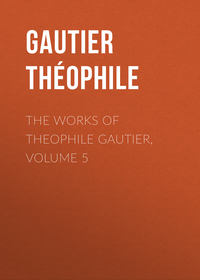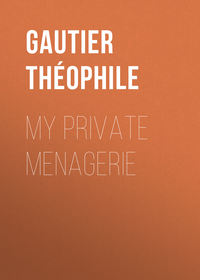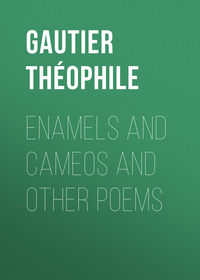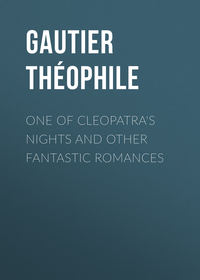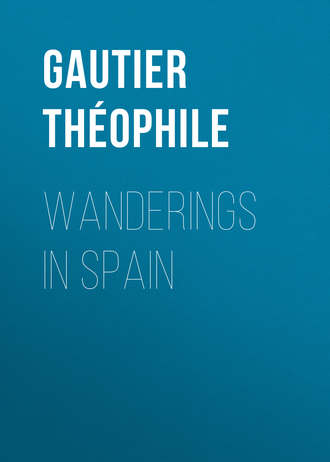 полная версия
полная версияWanderings in Spain
The craving for the true, however revolting, is a characteristic feature of Spanish art. Idealism and conventionality are foreign to the genius of this people, who are altogether deficient in everything like æsthetic feeling. For them sculpture is not sufficient; they require their statues to be coloured, and their Virgins to be painted and clothed in real clothes. To please them, the material illusion can never be carried too far; and their unbridled passion for the real causes them sometimes to overstep the line which separates the sculptor's studio from the boiling-room of the wax-work exhibitor.
The celebrated "Christ of Burgos," which is held in such veneration, and which must not be shown until the tapers are lighted, is a striking example of this strange taste. It is not formed of coloured stone or wood, but actually consists of a human skin (at least, so they say), stuffed in the most artistic manner. The hair is real hair; the eyes are furnished with eye-lashes, the crown of thorns is really composed of thorns, and, in a word, not one detail is omitted. Nothing can be more lugubrious, or more disagreeable to behold than this crucified phantom, with its ghastly life-like look and its death-like stillness. The skin, of a brownish, rusty tinge, is streaked with long lines of blood, which are so well imitated that you might almost think they were actually trickling down. It requires no very great effort of the imagination to believe the legend which affirms that this miraculous figure bleeds every Friday.
Instead of flying drapery twisted round the body, the Burgalise Christ has got on a white tunic, embroidered with gold, and descending from the waist to the knees. This style of dress produces a strange effect, especially upon us who are not used to it. There are three ostrich-eggs encased in the foot of the cross as a sort of symbolical ornament, the meaning of which I have forgotten, however, unless they are intended to convey an allusion to the Trinity, which is the principle and germ of all things.
On leaving the cathedral we felt dazzled and crushed with chefs-d'œuvre: we were intoxicated with them; we could not admire any longer: it was only by the greatest effort that we were enabled to cast a careless glance on the arch erected to Fernan Gonzalez: it is an experiment made in the classical style, at the commencement of the Renaissance period, by Philip of Burgundy. We were also shown the Cid's house; when I say the Cid's house, I express myself badly; I mean the place where his house may have been, and which is a square place enclosed by posts. There is not the least vestige left which can authorize the general belief; but then, on the other hand, nothing absolutely proves the contrary; and, such being the case, there is no harm in our trusting the tradition. The Casa del Cordon, so called from the rope which winds round the doors, borders the windows, and serpentines through the various ornaments, is worth examining. It is the residence of the political chief of the province, and we met there sundry alcades of the environs, with features that would have struck us as rather suspicious had we happened to come across them in some lonely spot, and who would have done well to ask themselves for their papers before allowing themselves to proceed without molestation on their road.
The Puerta de Santa Maria, erected in honour of Charles V., is a remarkable piece of architecture. Although the statues placed in the niches are short and squat, they have an appearance of force and vigour which amply compensates for any defect in gracefulness of form. It is a great pity that this superb triumphal arch should be obstructed and disfigured by a number of plaster walls, which are placed there under the pretence of their being fortifications; they should immediately be pulled down. Near this gate is the public promenade on the banks of the Arlanzon, a very respectable river at least two feet deep, which is a great depth for Spain. The promenade is ornamented with four very tolerable statues, representing four kings or counts of Castile – namely, Don Fernan Gonzalez, Don Alonzo, Don Enrique II., and Don Fernando I. I have now mentioned almost everything worth seeing at Burgos. The theatre is even more primitive than the one at Vittoria. The evening I was there, the performance consisted of a piece in verse, entitled "El Zapatero y el Rey" (the Cobbler and the King), by Zorilla, a young and very talented author, who is very popular in Madrid, and who has already published seven volumes of poetry much extolled for its harmony and style. All the places, however, had been taken beforehand, so that we were obliged to renounce the pleasure we had promised ourselves, and wait until the next night for the "Three Sultanas," which, we were informed, was a piece interspersed with singing and Turkish dances of the most transcendent comicality. The actors did not know a word of their parts, and the prompter spoke so loudly that he completely drowned their voices. I may mention that the prompter is protected by a sort of tin shell, arched like the roof of an oven, to shield him against the patatas, manzanas, and cascaras de naranja– potatoes, apples, and orange-peel – with which the Spanish public, as impatient a public as ever existed, never fails to bombard those actors who displease them. Each person brings his store of projectiles in his pocket: if the actors play well, the various vegetables return to the saucepan and serve to augment the puchero.
For one moment, we thought we had at length discovered the true type of a Spanish beauty in one of the three sultanas – large, arched, black eyebrows, sharp nose, a long oval face, and red lips; but an obliging neighbour informed us that she was a young French girl.
Before leaving Burgos, we paid a visit to the Cartuja de Miraflores, situated at half a league from the town. A few poor old decrepit monks have been allowed to await their death there. Spain has lost a great deal of its romantic character by the suppression of the monks, and I do not see that it has gained much in other respects. A number of magnificent edifices, which can never be replaced, and which were formerly preserved in all their integrity, will fall into a state of dilapidation, and crumble to the ground, adding their ruins to those which are already so common in this unhappy country; and thus unheard-of treasures in the way of statues, pictures, and objects of art of all kinds, will be lost, without any one deriving the least advantage. It strikes me that our Revolution might be imitated in other things than its stupid Vandalism. Murder each other if you will, for the ideas you imagine that you possess; fatten with your bodies the meagre plains ravaged by war – that is all very well; but the stone, the marble and the bronze touched by genius, are sacred – at least spare them. In two thousand years your civil dissensions will all be forgotten, and the future will only know that you were once a great people by some marvellous fragments dug from out a heap of ruins.
The Cartuja is situated upon a hill. Its exterior is austere and simple, consisting of grey stones and a tile roof, that says nothing to the eyes, but everything to the imagination. In the interior are long, cool, silent cloisters, with whitewashed walls, and a number of doors leading to the various cells, and windows with leaden casements, containing different religious subjects on stained glass, especially a remarkable composition representing the Ascension. The body of our Saviour has already disappeared; there is nothing left but his feet, the marks of which are seen on a rock which is surrounded by pious personages lost in admiration.
The prior's garden is situated within a little courtyard, in the midst of which is a fountain, from which the water, clear as crystal, runs out drop by drop. A few stray sprigs of the vine somewhat enliven the melancholy aspect of the walls, while a few tufts of flowers and clusters of plants are seen springing up here and there, in picturesque disorder, pretty much as they were sown by the hand of Chance. The prior, an old man, with a noble, venerable face, and dressed in a garment resembling as much as possible a gown (for monks are not allowed to preserve their costume), received us very politely, and, as it was not very warm, made us sit around the brazero, and offered us cigarettes and azucarillos, with cool spring water. An open book was lying on the table: I took the liberty to glance into it. It was the "Bibliotheca Cartuxiana," a collection of all the passages of the various authors who have written in praise of the order and lives of the Carthusian monks. The margin was covered with annotations, written in that stiff, formal, priest-like hand, rather large, which appeals so strongly to the imagination, but says nothing to the hasty and offhand man of the world. This poor old monk, left thus, out of pity, in a deserted convent, the vaults of which will soon fall over his unknown grave, was still dreaming of the glory of his order, and inscribing with a trembling hand, in the blank spaces of the book, some passage or other that had either been forgotten, or recently been found.
The cemetery is shaded by two or three large yew-trees, like those in the Turkish cemeteries. It contains four hundred and nineteen monks, who have died since the foundation of the convent. The ground is covered by thick luxuriant grass, and neither tomb, cross, nor inscription, is to be seen. There do the good monks all lie together, as humble in death as they were in life. This cemetery, without a single name, has something calm and silent about it that is refreshing to the soul. A fountain situated in the midst of it sheds a stream of limpid tears, as bright as silver, for these poor creatures, all dead and forgotten. I took a draught of the water, filtered through the ashes of so many holy persons; it was pure, and icy as death.
But though the dwelling of man is poor, that of God is rich. In the middle of the nave are placed the tombs of Don Juan II. and Queen Isabella, his wife. The spectator is lost in astonishment at the fact of human patience ever having completed such a work. Sixteen lions, two at each angle, support eight shields with the royal arms, and serve as base to the structure. Add to these a proportionate number of virtues, allegorical figures, apostles, and evangelists, imagine a countless number of branches, birds, animals, scrolls of arabesque and foliage, twisting and twining in every direction, and you will yet have but a feeble notion of this prodigious masterpiece. The crowned statues of the king and queen are lying at full length on the top of the tomb. The king is holding his sceptre in his hand, and is enveloped in a long robe, guilloched and figured with the most incredible delicacy.
The tomb of the Infante Alonzo is on the left-hand side of the altar. The Infante is represented kneeling before a fall-stool. A vine, with open spaces, in which little children gathering grapes are suspended, creeps, in festoons of the most capricious and endless variety around the Gothic arch that serves as a framework to the composition, half buried in the thickness of the wall. These marvellous monuments are in alabaster, and are due to the chisel of Gil de Siloe, who also executed the sculptures for the high altar. To the right and left of the latter, which is a most beautiful work of art, are two open doors, through which you perceive two Carthusian friars in the white robe of their order, standing motionless before you. At first sight you are inclined to take these two figures, which are probably by Diego de Leyva, for living beings. The general decoration of the building is completed by stalls in the Berruguete style, and it is a matter of astonishment for the visitor to find all these wonders in so deserted a spot.
From the top of the hill we were shown, in the distance, San Pedro de Cardeña, which contains the tomb of the Cid and of his wife, Doña Ximena. By the way, in connexion with this tomb there is a strange anecdote told, which I will here relate, without, however, answering for the truth of it.
During the French invasion, General Thibaut conceived the idea of having the Cid's bones removed from San Pedro de Cardeña to Burgos. His intention was to place them in a sarcophagus on the public promenade, in order that the presence of these illustrious remains might inspire the people with sentiments of heroism and chivalry. It is added, that the gallant general, in a fit of warlike enthusiasm, placed the hero's bones in his own bed, in order that he might elevate his courage by this glorious proximity, a precaution of which he had no need. The project was not put into execution, and the Cid returned to Doña Ximena's side, at San Pedro de Cardeña, where he has since remained; but one of his teeth, which had fallen out, and which had been put away in a drawer, had disappeared, without any one being able to find out what had become of it. The only thing that was wanting to complete the Cid's glory, was that he should be canonized, which he would have been, had he not, before his death, expressed the Arabo-heretical and suspicious wish that his famous steed, Barbieca, should be buried with him. This caused his orthodoxy to be doubted. Talking of the Cid, I must remark to Monsieur Casimir Delavigne that the name of the hero's sword is Tizona, and not Tizonade, which rhymes rather too closely with lemonade. I say this, however, without any desire of damaging the Cid's fame, who, to his merit as a hero, added that of inspiring so poetically the unknown author of the Romancero, as well as Guilhen de Castro, Diamante, and Pierre Corneille.
CHAPTER V
FROM BURGOS TO MADRID
El Correo Real; the Galeras – Valladolid – San Pablo – A Representation of Hernani – Santa Maria – Madrid.El Correo Real in which we quitted Burgos merits a particular description. Just fancy an antediluvian vehicle, of which I should say that the model, long since discarded, could at present only be found in the fossil remains of Spain; immense bell-shaped wheels, with very thin spokes, placed considerably behind the frame, which had been painted red, somewhere about the time of Isabella the Catholic; an extravagant body, full of all sorts of crooked windows, and lined in the inside with small satin cushions, which may, at some remote period, have been rose-coloured; and the whole interior quilted and decorated with a kind of silk that was once, probably, of various colours. This respectable conveyance was suspended by the aid of ropes, and bound together in several suspicious-looking places with thin cords made of spartum. To this precious machine was added a team of mules of a reasonable length, with an assortment of postilions, and a mayoral clad in an Astracan lambs-wool waistcoat, and a pair of sheepskin trousers which looked tremendously Muscovitish. When all our preparations were completed, we set off in the midst of a whirlwind of cries and oaths, accompanied by a due proportion of whipping. We went at a most terrific pace, and literally flew over the ground, the vague outlines of the objects to our right and left flitting past us with phantasmagorical rapidity. I never saw mules more fiery, more restive, and more wild; every time we stopped, a whole army of muchachos was requisite to harness one to the coach. The diabolical animals came out of their stables on their hind legs; and it was only by the instrumentality of a bunch of postilions hanging on the halter of each one, that we succeeded in again reducing them to the state of quadrupeds. I think that it was the idea of the food that awaited them at the next venta– for they were frightfully thin – which filled them with this fiendlike impetuosity. On leaving one small village, they commenced kicking and capering about in such a fashion that their legs got entangled in the traces; whereupon they were belaboured with a shower of blows and kicks which must be seen to be believed. The whole team fell down, and an unfortunate postilion, who was mounted on a horse which in all probability had never before been in harness, was dragged from beneath this heap of animals, almost as flat as a pancake and bleeding from the nose. His sweetheart, who had come to see him off, began shrieking enough to break any person's heart; I should never have thought that such shrieks could proceed from a human breast. The ropes were at last disentangled, and the mules set upon their feet again. Another postilion took the place of the wounded man, and we set off with a velocity which I should say could not be surpassed. The country through which we passed had a strange, savage look; it consisted of immense arid plains without a single tree to break their uniformity, and terminated by mountains and hills of a yellow-ochreish hue, which with difficulty assumed an azure tint even at a distance. From time to time we passed a dusty mud-built village, mostly in ruins. As it was Sunday, we saw, all along the yellowish walls illuminated by a sickly sun, whole ranks of haughty Castilians as motionless as mummies, and enveloped in their tinder-like rags, who had placed themselves there to tomar el sol, a species of amusement which would cause the most phlegmatic German to die of ennui at the expiration of an hour. This peculiarly Spanish amusement was, however, on the day in question, very excusable, for the weather was atrociously cold, while a furious wind swept the plain with the noise of thunder and of an infinity of war-chariots filled with armour rattling over a succession of brazen vaults. I do not believe that anything more barbarous and more primitive can be met with in the kraals of the Hottentots and the encampments of the Calmucks. I took advantage of a halt to enter one of these huts. It was a wretched hovel, without any windows. It had a fireplace of unhewn stones in the centre, and a hole in the roof for the smoke to escape. The walls were of a dark brown colour, worthy of Rembrandt.
We dined at Torrequemada, a village situated on a small river which is choked up by the ruins of some old fortifications. Torrequemada is remarkable for the total absence of glass; the only window-panes to be seen there are in the parador, which, in spite of this unheard-of luxury, is nothing more nor less than a kitchen with a hole in the ceiling. After having swallowed a few garbanzos, which rattled in our stomachs like shots in a tambourine, we re-entered our box, and the steeple-chase recommenced. The coach at the back of the mules was like a saucepan tied to the tail of a tiger, and the noise it made only served to render them still more excited than they were before. A straw fire that was lighted in the middle of the road nearly caused them to set off with the bit between their teeth. They were so shy, that it was necessary for the postilions to catch hold of them by the bridle, and cover their eyes with their hands whenever another carriage was approaching them from the opposite direction. It may be taken as a general rule, that when two carriages drawn by mules meet, one of them is destined to capsize. At last, what was to happen, did happen. I was engaged in turning over in my brain the end of some hemi-stich or other, as I am accustomed to do on my travels, when I saw my companion, who was seated opposite to me, describe a rapid parabola in my direction. This strange action was followed by a severe shock and a general cracking. "Are you killed?" said my friend, finishing his curve. "Quite the contrary," I replied; "and you?" "Very slightly," was his answer. We made our way out as speedily as possible through the shattered roof of the unfortunate coach, which was shivered into a thousand pieces. It was with an infinite degree of satisfaction that, at about fifteen paces off, we beheld in a field the box of our daguerreotype, as perfect and unharmed as if it had still been in Susse's shop, engaged in producing views of the Colonnade of the Bourse. As for the mules, they had disappeared, carrying off with them, Heaven knows whither, the front part of the carriage, and the two small wheels. Our own loss was limited to a button, which flew off with the violence of the concussion, and which we were unable to find. In sober truth, it would be impossible for any one to capsize more admirably.
I never in my life saw anything so ridiculous as the mayoral lamenting over the ruins of his coach. He put the pieces together just like a child who has broken a tumbler; finding, however, that the damage was irreparable, he began swearing most awfully; he beat himself, he rolled upon the ground, and imitated all the excess of grief as represented by the ancients; the next moment he softened down, and gave free course to the most touching elegies. What grieved him most was the rose-coloured cushions, scattered in all directions, torn and covered with dirt; these cushions were evidently the most magnificent things that he, as a mayoral, could conceive, and his heart bled to see that so much splendour had for ever vanished.
After all, our situation was not over pleasant, although we were seized with a most violent fit of laughter, which was certainly rather ill-timed. Our mules had disappeared like smoke, and all that we had left was a dismantled carriage without wheels. Luckily, the venta was not far off. Some one went and procured two galeras, which came for us and our luggage. The galera (galley) most undoubtedly justifies those who gave it the name it bears. It is a cart on two or four wheels, with neither top nor bottom. A number of cords made of reeds form, in the lower portion of it, a sort of net, in which the packages and trunks are stowed. Over these is spread a mattress – a real Spanish mattress – which in no way prevents you from feeling the sharp angles of the baggage, thrown in any how beneath. The victims arrange themselves, as well as they can, on this novel instrument of torture, compared to which the gridirons of Saint Lawrence and Guatimozin are beds of roses; for on them, at least, it was possible to turn round. What would the philanthropists, who give galley-slaves post-chaises to ride in, say, if they saw the galeras to which the most innocent people in the world are condemned, when they visit Spain?
In this agreeable vehicle, completely innocent of anything like springs, we went along at the rate of four Spanish leagues, which are equal to five French leagues, an hour; just one mile an hour more than the rate attained by our best horsed mails on our best roads. Had we desired to have gone faster we must have procured English racers or hunters. Our route was diversified by a succession of steep ascents and rapid descents, down which we always rattled at a most furious gallop. All the assurance and skill for which Spanish postilions and conductors are famous was requisite to prevent our being shivered into a thousand pieces at the bottom of the various precipices; instead of capsizing merely once, we ought to have been capsizing without intermission. We were thrown from one side to the other like mice, when a person shakes them about for the purpose of stunning and killing them against the sides of the trap. Nothing but the severe beauty of the landscape could have prevented us from becoming melancholy and crooked in the back; but the lovely hills, with their austere outline, and their sober, calm tints, imparted such a distinctive character to the horizon, which was changing every moment, that they more than compensated for the jolting we got in the galera. A village, or some old convent, built like a fortress, varied the oriental simplicity of the view, which reminded us strongly of the background of Decamps's picture of "Joseph sold by his Brethren."
Dueñas, which is situated upon a hill, looks like a Turkish cemetery. The caverns, scooped out of the living rock, are supplied with air by little bell-shaped towers, which at first sight bear a singular resemblance to minarets. A Moorish-looking church completes the illusion. To our left, in the plain, we caught occasional glimpses of the canal of Castile; it is not yet completed.
At Venta de Trigueros, a most singularly beautiful rose-coloured horse was harnessed to the galera. We had given up mules. This horse fully justified the one which has been so much criticised in the "Triumph of Trajan," by Eugene Delacroix. Genius is always right. Whatever it invents, exists; and Nature imitates it in almost its most fantastic eccentricities. After crossing a road skirted by mounds and jutting buttresses, which presented a tolerably monumental appearance, we at last entered Valladolid, slightly bruised, but with our noses undamaged, and our arms still hanging to our bodies without the assistance of black pins, like the arms of a new doll. I cannot say much for our legs, in which we seemed to feel all the pins and needles that were ever manufactured in England, as well as the feet of a hundred thousand invisible ants. We alighted in a superb and scrupulously clean parador, where we were ushered into two splendid rooms, with balconies looking out upon a square, coloured matting, and walls painted in distemper, yellow and russet-green. As yet we had met with nothing which could justify the charge of uncleanliness and poverty, which travellers make against Spanish inns; we had not found any scorpions in our beds, and the promised insects had not made their appearance.




